Introduction
Newer process generation, implementation and evaluation are integrated part of organisational innovativeness in terms of operation and management. So, as an external management consultant, such an innovative practice can be suggested in a SME based organisational context that can be either related with some allied field of corporate development like- introducing new product, existing process improvement, technological revolution, change in organisational culture and behavior or change that can be made through acquisition.
All of those issues can make a dramatic change in current process while emphasize on technological factors are most prominent in all aspects of innovation. From this point of view, this entire report would be presented by taking a number of criteria in mind regarding the concept of innovation and change inclusive of necessity of innovation at a SME project phasing. An SME company running on general line of process preparation and handling, used methodology in those sectors, effectiveness and limitations of those applications, rationalizing technology evolving e- commerce as an innovative practice within that company.
Several suggestions regarding the benefits applicability of some e- commerce tools, situational constraints of such strategy, recommendations to come up those problems for achieving productive and communicative efficiency and finally, an ending notes focusing each of the components discussed previously to show up a combined sense of effectiveness. From a further exploratory sense, the discussion will be started upon the factorial incorporation of innovation in the background of short and middle size firms. To generalize this concept, it would be helpful to idealized innovation through an “I + D + I” definition by amplifying investigation or search with development by diverging upon 3 issues involving general and applied investigation and technological diversification and renovation.
Although the conventional periods have posed some limitations of this complex process of innovation upon this SME industry, modern age has adopted a wider vision for a continuous development of innovation in those firms. Thus, this report will be closely associated with an integrated aspect of emphasizing the innovative approaches regarding newer product, concept, market, raw material or some other processes among which technology will have been selected because of its wide array of corporate development and regenerating protocol covering marketing, finance, HR, operations and OS.
Among the vast area of technology, like e- commerce, IT or IS, the first one has been preferred to show its further implementation in the selected company named as Danisco, a leading food and beverage ingredients solver having a diversified criteria of such operations into which the farthest technological application like e- commerce is viable.
However, after covering the relevant organisational intrinsic worth, the next phase will be to go forward with a number of e- business tools in those of the proposed fields, such as- ECM, EFD, e- marketing, OLTP, EDI, e- mail, online shopping, or teleconferencing. Offering both long and short- term implementation discussion of those techniques, it will be necessary to focus on some of the breakdowns of each of the procedure in terms of time, usability, customer security, complexity, knowledge and cost factors. At last, a conclusion will predict the project validity, rigidity, and acceptability in the end by re- assessing the current market competition by ensuring the company’s profitability and sustainability.
Integration of innovation with SME
As a management consultant, primarily it is very much essential to understand the systematic process view of innovation and its future in a SME firm. Theoretically, innovation is an imperative reformative way that helps a company for sustainable development in a complex vibrant marketing environment. So, it can be observed either by evolving a new product, new ways of production, discovering latest market criteria or vendors or raw materials or finally, moving out the company in much larger context. However, now- a- days all of those approaches are widely used in small and medium sized corporations for the requirement of collaboration widely. Since, such industry generally suffers from monetary and HR problems, mutual agreements are helpful for it to sustain in this competitive framework.
For idealising such a particular relationship between innovation and SME, it will be logical of having a clear view about both of the concepts. As we have learnt earlier that to be innovative the product or the process must be acknowledged by the target market that would be the fundamental effort of value generation in terms of new feature, dimension, or strategy. Innovation can be of various types of which the following are mostly important-
- Product innovation: Changed nature of a product, which can be commercialized, & technically superiority is considered as an innovation of a product.
- Process innovation: Refers to the significant change in techniques or producing the goods as well as variability in its direction and formulation method.
It can also be classified from the viewpoint of diffusion. As-
- Continuous Innovation: It is similar to product innovation.
- Dynamically Continuous Innovation: It involves the creation & radical change of a product.
- Discontinuous Innovation: It is the total invention of new product, which has not been seen before.
So, the most important 5 nature or characteristics of innovation can be placed as-
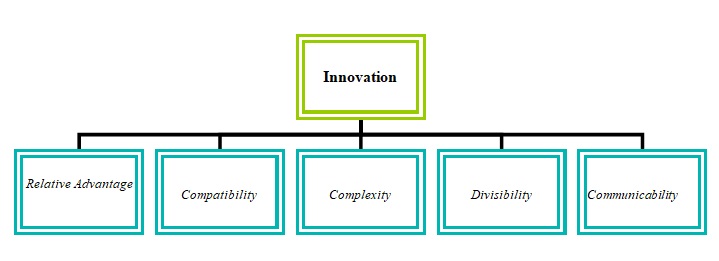
- Relative advantage- This idea can be judged regarding of other facts like advantage of storage or unpredictable & uncontrollable facts.
- Compatibility- It is the innovational fitness in a specific society, as much as it is smooth in a culture; it is the suggestion for faster rate of adoption.
- Complexity- If the innovation is hard to understand or least professed value to execute, the adopter will devour it less.
- Divisibility- This is the capability of a customer of giving the innovation a testing part prior to the decision of embracing.
- Communicability- It states that when the benefit of innovation does not quickly solve a consumer’s complexity, it will reject to diffuse through a society or the public relative to the innovation.
On the other hand, definition of small and medium size companies vary from country to country based on the nature of demand. In general, the UK based SME posses a high opportunity and comparative background for adopting new types of technological support than the gigantic ones, which often suffer from bureaucratic complexity. Innovation also offers relatively more facilities for obtaining more vendors and customers in such era of market where those companies have not touched before whether in domestic and global situation. Today, markets are expanding rapidly with the use of internet while technologies like e- commerce get them to compete strongly as with the threshold level to survive.
So, all kinds of innovation will be helpful for a SME firm for adequate value generation, as-
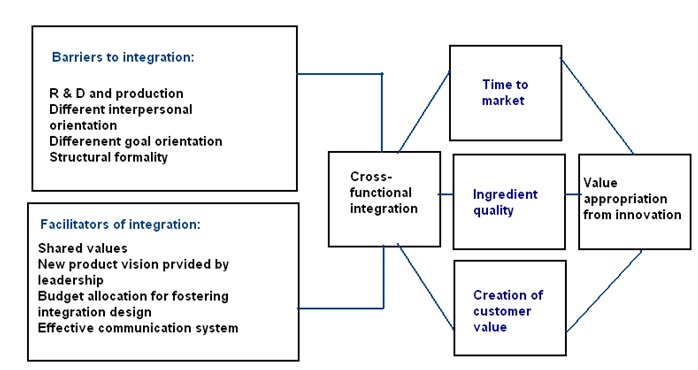
Such background incorporates relevant cultural limitations as technical transportation, women participation, centralized logistics etc. Other conditions are-
- At first , several knowledge is necessary for the SME to conceptualize, such as-
- Practical needs of using technology as well as its intended benefits,
- Search for the way for improving the business with innovative practices.
- Determine which parts can be mostly appropriate for better integration of newness or changing.
- Determine what techniques are usable at overall circumstances.
- Understanding organizational resources for successfully implementing the innovative strategy,
- Calculation of overall costs of innovation against its desired benefits,
- Setting up the effective timing to start the real life implementation task,
- Affixing the way of evaluation of judging the whole output.
- Then, the effective innovative contribution can change several situational constraints by some following criteria-
- Turning the point of accumulating competitive advantage,
- Enhance key skills of the personnel.
- Motivate the customers for having better services at easier module.
- Raising the product or service delivery at JIT or just- in- time technique,
- Enhancing competition based on TQM,
- Emphasizing the SME suppliers to expand their service at a broader range,
- Better scope for adopting globalization,
- Decentralization of the traditional market,
- Risk reduction opportunity,
- More and more R and D effort for sustainable development,
- Scope of generating a “learning organization”,
- Effective communication from all levels or parties internally or externally.
- Wider access to the customer base,
- Initiation of communication essence in various departments,
- Scope of engineering and re- engineering within the firm,
- Flexible and simplified structure of the organization,
- Development of tem spirit or teamwork,
- Opportunity to develop strategic alliances,
- Development of an image of innovative culture within the business area,
- Decrease costs compared with the static competitors.
- Other factors that are encompassing the necessity of innovation in SME field can be placed below-
- From the very beginning of Schumpeterian research, it has been idealized that SME posses the higher potential than the larger ones because of the shorter progress time and more closeness with the market.
- SME can also integrate successful technological accomplishment in all areas of its operations involving marketing, finance, human resource, and organizational structure.
- Revitalization helps to pass several hindrances by optimizing the level of performance, R and D effort and removal of sharing issues etc.
- Maintenance of humanizing quality and stabilizing international market competitiveness by ensuring its survival,
- Distribution and supply chain networks are mostly facilitated by innovative practices as it converts the corporate character as “interactive” for a clear circulation of forward, backward, vertical, horizontal, and lateral linkages inside and outside of the projected firm with lower costs and appropriate use of modern informational devices.
Company selection
Regarding all of the perquisites in formational methodology, an UK based SME Company named Danisco Sweeteners Ltd has been selected which is Danisco Sweeteners Ltd. is an SME organisation of UK under Danisco as a subsidiary. is popular as a maker of food ingredients, enzymes and bio-based solutions, which have rich and innovative portfolio in global market as SME. They are producing healthy and safe products with the natural materials, science and knowledge of their own. The ingredients of Danisco Sweeteners Ltd. are used in bakery, dairy, beverages, animal feed and many more in global market.
Danisco Sweeteners Ltd is an UK based SME and a member of FDF (Food and Drink Federation, UK) under SME category. The various ranges of ingredients and raw materialslike D-xylose, Fructose, Lactitol, Polydextrose and Xylitol those Danisco produces are known as flexible, ironing out, and material quality with requirements of manufacturers. This company has been chosen for having some specific characteristics as with the appropriation of required analytical view.
Several reasons for choosing this company can be explained as below-
- Feasibility in general SME considerations or framework,
- Implementation criteria of having a general practice of developing changes and innovativeness through a number of strategies,
- Generalization of some newer and common business practices ranging from purchasing to supply management network.
- Offering scope of implementing some technological supporting system concerning its basic featuring and natures in terms of the following aspects-
- Need of using technology by evolving the advantages.
- Determination of necessary procedures,
- Determination of corporate process identification,
- Success planning by engaging more effective R and D,
- Calculative approach of cost- benefits analysis,
- Scope of following up and monitoring,
- Intended action plan for continuing viability,
- Influence of external ingredients for the implementation.
- Danisco is also preferable because of its fixed intension of setting of major innovational goals by means of product, application, and process development that clearly states the optimism in forthcoming trend in adopting more upgraded objectives.
- The gradual development process of business can show the scenario of identification, acquisition and licensing latest products or technologies collected from the outsider sources with a gradual expansion of biotechnological field as another scope of adopting suggestions for modern IT support.
- Danisco is also suitable for expanding the scope of management of knowledge for cost controlling, innovative process generation, improvement in sales process and wider connectivity with customers.
- It has already adopted a few e- commerce processes like- internet, online shopping cart, partner web etc. which projects can be expanded more along with the implication of some other tools like- EDI, OLTP, teleconferencing etc.
- Moreover, the company has existing platform that proves its situational advantage to become successful as a click- and- mortar as well as a significant brick- and- mortar entity in the related field.
Topic selection
According to the guidelines, there is several alternative topics like- process of product development, techniques of process development, change in technology, cultural change or acquisition technique among which a specific issue has been selected which name along with its necessity, scope and relevance are explained below-
- Suggested are: – From given areas of innovation, technological change has been chosen that will be explained thoroughly with its newer dimensions in the mentioned “Danisco” company view.
- Scope of technology: – By technology, we generally understand the set of process and systems used by the company to convert resources into products or services. It is mainly of two sizes as-
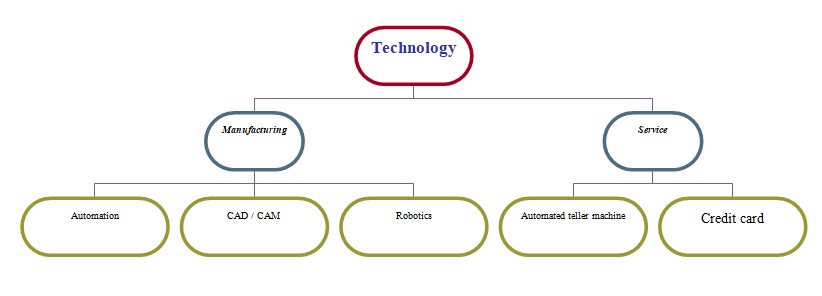
After choosing such topic, a traditional question may arouse in mind why technology has specially been selected. The answer would be very simple- because of its underlying scopes in modern competitive business age. Some of such scopes of technology can be discussed here-
- The technology- practice framework is helpful to show the multipart nature of technological application within 3 most important aspects of the company as below-
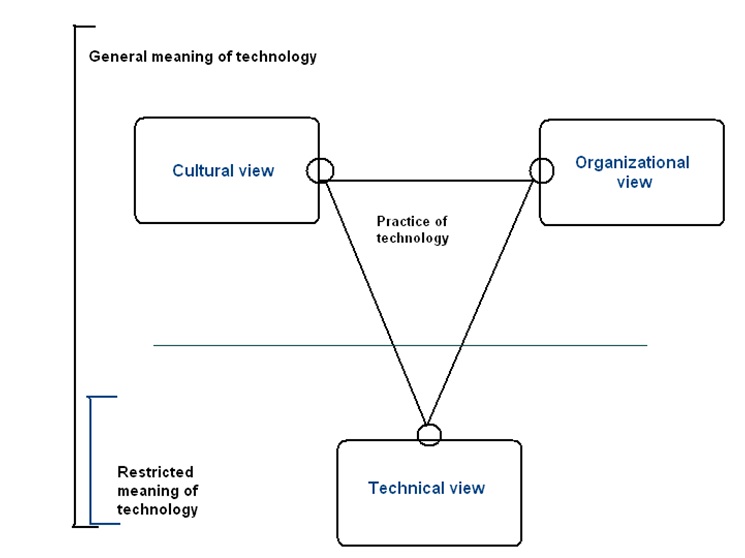
- Therefore, technology can be mostly powerful in changing cultural framework of an organization through the coping of cultural diffusion. Other components like- organizational and instrumental is essential for a proper co- ordination in terms of the efficient workforce, customisation checkup, order handling etc.
- The context of learning technology is also helpful in original usability for bringing an overall welfare of the system. It can be graphically shown as-
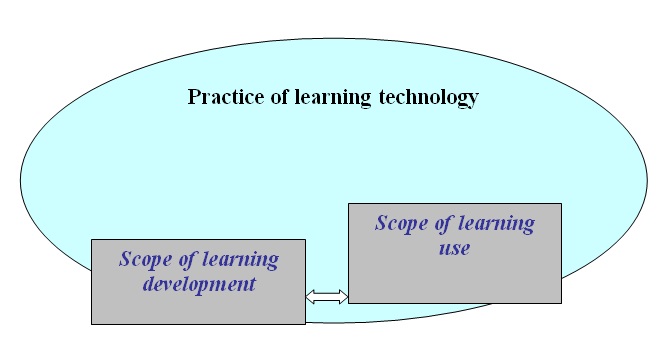
- Technology can also been implemented at various management level involving top, middle and lower level segment including knowledge workers as specialists, scientists, IT experts for renovating new process.
- The scope of technology is also expanded at various functional areas of business regarding marketing, finance, accounting, operations etc. While different businesses are organized regarding different processes, all of those groups need information transmitted various inter- corporate department.
- Information technology lies at one of the top place of a company in terms of various system tools like-
- TPS or transaction processing system is the implementation of processing information for regular business transactions.
- Techniques for knowledge workers and office applications are effective for data processing and office activities.
- MIS or management information system can support a company’s manager by delivering daily reports, plans, schedules, and budgets.
- DSS or decision support system is an interactive system that can locate and present information essential for supporting decision- making methodology.
- ESS or executive support system is designed for giving an instant access by top- level management.
- AI or artificial intelligence can be idealized as the growth of computer system in terms of hardware and software for initiating manners of human for performing visible tasks by using mental process of thinking and learning.
- Advantages of technology: – Thus, understanding the different usable fields of technology, it is also possible to make a clear sense over it-
- Flexible operations: – Electronic networks permit the businesses of offering the customers greater diversity and smooth delivery cycles. Similarly, flexible production and faster delivery depends on an incorporated network of coordinating all transactions, actions and processes for quick modification.
- Increased level of collaboration: – Collaboration increases not only among the internal units of the firm but also exterior of it. Corporate buyers and vendors are becoming so intimately networked that may perceived to be working within the same company. Here, teamwork can also be composed on the theme of expertise in marketing, distribution, promotion etc.
- Flexible site of works: – The use of e- commerce can significantly removes the essence and problem of geographically centralized periods of working. Thus, the employees need no to work only at office or factory but only an easy utilization of internet or e- business.
- Improved managerial process: – Networking system has significantly changed the activities, procedures and trends in today’s managerial work style. Through these networks, timely information is available in a convenient and functional format. It is also helpful for getting current status of customer order, measure productivity of each work side with an extra analyze of delivery performance. Moreover, managers can better coordinate by using software system like- SAP, ERP or SPSS.
- Changed behavior of employees: – Information technology is mostly important in this issue. It is helpful in improving efficiency by converting the productive activity into fun as by use of e- mail.
Topic evaluation
Under the broader topic of technological change, the elaborative criterion has been selected as e-commerce or electric commerce. Other terms about it as following-
Conceptualizing e-commerce
By e- commerce, we generally understand the utilization if internet as well as the web for transacting the venture. More specifically, it is digitally enabled profit-making dealings involving among the corporations and individuals. Thus, each of the parts of its definition can be put off importance. Such as-
- Digitally capable transaction means all dealings mediated by digital expertise.
- Commercial transaction includes the trade of values across organizational or personal borders for returning the commodities or services.
Therefore, the seven unique characteristics of e- commerce and its application can be idealized through the following table-
In short, e-commerce can be classified into four categories, as-
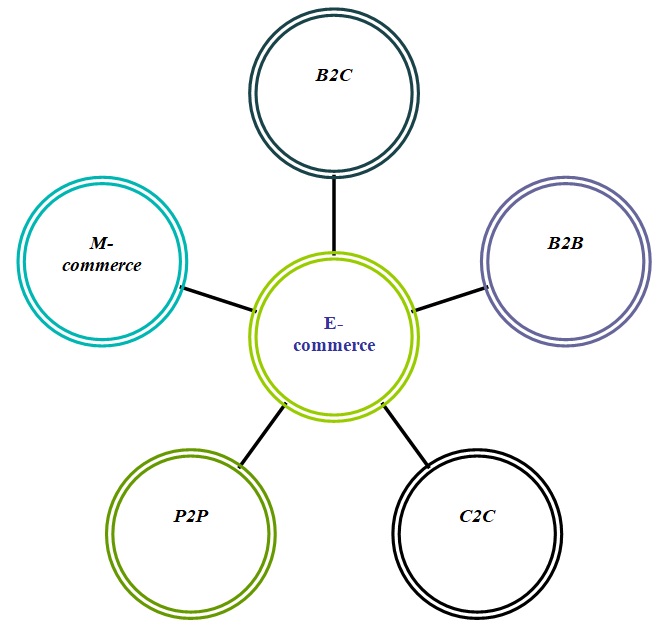
- B2C- Business to consumers: Web based business of selling goods to final consumers.
- B2B- Business to business: Online selling of goods to other business,
- C2C- Consumers to consumers: It supplies the way for customers of selling merchandise to others.
- P2P- Peer to peer: Using of technology that enables the internet subscribers of distributing files and computer wealth directly with no need to go along the major net server in e- commerce.
- M- commerce: It can be referred as the use of wireless digital procedure for making business on the web.
The organizing theme of e-commerce can be understood by the following three dimensions-
Technological infrastructure
The progress and mastery of digital computation and contact technology is at the heart of the e- commerce. Thus, the internet and the emerging corporate computing can be explained as-
- Basic business concepts: Newer technologies are near to the company and entrepreneurs with upgraded ways of organizing production and transacting business. New technologies modify the strategy or tactics of present companies. Here, some popular terms like- electronic markets, business models, information goods, company or industry value series, structure of the industry and consumer behavior are popular.
- Societal view: Increasingly, e-commerce is becoming the subject of laws of countries and international entities. The preliminary social issues are intellectual assets, privacy policy and personal privacy.
- Necessity of e-commerce: – The idea of e- commerce has been emerged day- by-day because of number of inherent advantages that it offers. Such as-
- Establishment of direct relationship with customers by disintermediation and contents originators are with their patrons.
- Establishment of friction- free- commerce that is a particular view in which information are alike distributed, transaction expenditures are less, prices can be especially accustomed for shimmering the original demand, mediators are reduced with a reduction of illegal competitive advantage.
- Enabling a firm has to move faster in a fixed area of a market for moving to achieve swift market share.
- Necessity of e-commerce in general SME concept: – For properly implementing such version of technology into the business, the SME first needs to understand the value of some primitive questions regarding the applicability, costs, benefits, timing, action etc. issues of e- commerce. Other considerations are as below-
- Entrepreneurial desires and capabilities take a very significant role in determining the way of changing the company through e- commerce which is somewhat difficult in SME context in terms of websites, documentation etc.
- Successful implementation can be visualized as the wider software support, general standards, and open font code. Moreover, the “pulling no punches” for ongoing business functioning, continuous support to the struggler can be noticed throughout the industry.
- Overall, e- commerce in SME context can derive new and more customers, associates and supplier both at national and global level.
- Offer the ongoing and newer users better and more sophisticated value than before.
- Improvement of competence in all units of the process of business,
- Takes part in innovation by initializing new goods and services as with the chance of starting new business.
- E-commerce does not strengthen economic equally rather than drastically change in information sensitive items that can be served electronically. In addition, it poses a high potential to be successful in price settlement, order placement, designing product or collaboration, supporting the customers and distribution of various documents.
- The use of “digital divide” can take a significant part in real life market growth for many SME companies.
- Closer integration with suppliers for the production or back- office support would raise transaction criteria of a SME as a part of e- business.
- Some specific tools of e- commerce can be mostly effective in many SME operations, as-
Company profile
The selected company can be discussed by emphasizing on its initial background and projected functional areas.
Short view of Danisco Sweeteners Ltd
Danisco is a European company that produces ingredients of foods, bio- focused solutions and enzymes had been established in 1989. It generally involves in the manufacturing and sales of materials as well as sugar for food and several other consumer goods. Several kinds of produced items involve antioxidants, colors, emulsifiers, fermentation medium, flavors, fibers, smells, dietetic and healthy ingredients, seeds, singular carbohydrates, formulated lipids, sweeteners, customized blends, industrial bio- goods etc. Additionally, it offers food and beverage, animation and agricultural products, health related goods and pharmaceuticals, paper producing conglomerates etc. With a multiple operating record, the company’s headquarter is located at Copenhagen in Denmark.
Motto of becoming the leader of global ingredient industry, Danisco runs with a mission of obliging customer demand of supplying healthy, safety and delicious food solution to diligence while the company operates on several areas of products like- 7% natural growth in texturing, 2% in specialty goods, 6% of sweeteners etc.
Corporate divisional details
Danisco is running its business operations by accommodating a lot of services explained as following-
- Danisco’s technological platform has been established through an innovational effort particularly in cultural and enzyme examination. Al of those innovative efforts had been generated to develop goods, implementation and process management which proves that it is confronted in self- ranged items but also eligible in offering vast range of ingredients with acknowledged application as one of the reasons of personal choice. Sometimes, it also takes the help of exterior outsourcing because of lack in technical support which has been resulted as many customers’ entrance in the expanded R and D agreement for a key of further development. On the other hand, Danisco’s patent is experiencing upper value as the four mega trend factors can be identified as population rate, growth of economy, properties and industrialization. Since, today people of all nations are suffering from a common problem of obesity; Danisco’s applied knowledge of accumulation of healthy materials coming at the focus of future generations provided a strong positioning support relative to two focus of emerging new and current development and competitive features of altering oily ingredients because of more price of oil.
- Regarding the business- level development, Danisco supports the newer area for identifying, obtaining or licensing from the outsider individuals. Here, the establishment of some evaluation projects is also mentionable for judging the scope of dieting and health issues. Thus, the three partnering companies have prominent role in such matter-
- Liguagen Corp.
- Direvo Biotech Corp.
- Profos AG.
- Managing knowledge takes important role particularly for taking over purpose although ingredient controlling is mostly knowledge and research oriented. It is running with an adequate utilization of resources by focusing on-
- Reduction of entire supply chain costs.
- Application in each innovative criterion of production, processing and implementation.
- Usability in sales management.
In this aspect, Danisco’s intranet provides maximum support through the distribution of skills, increasing employee accessibility for worldwide communication tools for generating extra value, competitive forces and accountability.
- Continuous experimentation in the bio- technology explores new angles of know- how by both self- protection and group monitoring.
- Effective CRM systems have been utilized in the previous years for optimizing potential selling by perfect resource distribution of individual server.
- Working on automated information distribution with selected customers and channel members in a regulated manner is consisted of-
- Partner web converges up to 4000 individuals usable system operator better that the general product development module.
- Web site shopping areas provide customers the opportunity of making and dealing with electronic order placement.
- SIM or supply management integration system communicates with customers and IT tools for the ease of inventory control within a simplified network agreement. While this process is comparatively new, it has been predicted into satisfactory cost- saver with a deduction in tied- up principal.
- The company is carrying out its sustainable development strategy from the sense of domestic and global rules and regulations. It treats such development more importantly than general regulation to delivering public demand along with an extra planning of customer insurance plan alongside possible problems. So, the base of sustainable development plan is to hold a fluent selling and production activities. The proactive sustainability focuses on various important dimensions, like-
- Vendor’s auditing
- Safety focused environmental concern along with quality
- Separate corporate functioning for food legislation and approval by using GRINDSTED SOFT-N-SAFE.
- Maintenance of organizational social responsibility with special concern for own employees along with customers and suppliers centered ethical values.
- Existence of due diligence investigation for judging the potential acquisition partners.
- Past contingency plans have been developed on a basic theme of proactively mentoring approach for tackling unusual or unexpected incidents that could be happened internal or external portion of the company like in supply chain or logistics system. Today, its contingency plan has been taken in such corporate level so that no single accident can easily affect it.
- As a technique of introducing open dialogue, Danisco goes for the following-
- Conducting employee appraisal.
- Conducting yearly survey of employees.
- Automated collaborating mechanism for conducting international group work.
- Use of intranet portals for effective knowledge communication.
- Building of competencies through internal and outsider e- learning programs that focus on traditional along with technological view.
- Regarding the production part of the company, it is practicing technological view by utilizing self- made raw materials and assets for developing required ingredients and finished items which are continuously being used in regular life.
- The value proposition network is generally concentrated upon supply chain situation by influencing service, goods, innovation and finally working results.
- In case of selling, Danisco maintains the three mottos of natural development, acquisition and research task. For doing so, it typically blends the following-
- Strong contact of sales stuffs with audience.
- Supply chain dispersion.
- Meeting customer requirements by drawing upon right agreement, appropriate distribution network surrounded by customer obstacles, establishing new order processing scheduling and more responsive network.
- For maintaining customer relationship, Danisco goes for predicting future trends through flexible relationship with members.
- And lastly, the company organizes various corporate functions in such way to maximize customer value with sustainable profitability.
Existing process view
Running with their existing operational mission, vision, goals and objectives, Danisco has a wider collection of products which are purchased, processed and delivered in such way that would be prospective for the company’s further development which can be viewed at a glance as below-
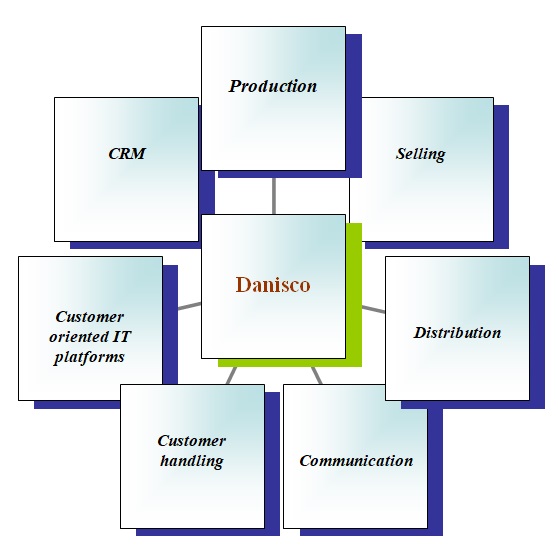
Innovative background
Danisco has major three goals for operating its current innovative projects which are mostly incorporated in newer knowledge, product and implemental situations advantageous for the organization. Thus, the overall innovative effort made by the company can be shown as output scenario as below-
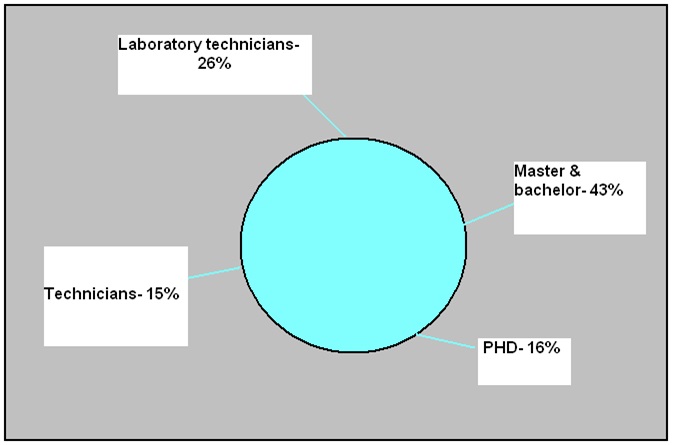
All of those processes are discussed in brief as following
- Since Danisco is very much inquisitive of producing each of its product by ensuring an innovative and creative quality, its specialist group posing specific knowledge for food materials and implementation capacity is adopted from various channels which initializes the development phases with extra- ordinary and superior goods as a continuous flow in the market.
- Examination for the production process takes place frequently with heterogeneous materials, technology and accomplishment by engaging potential workforce with the utilization of classy evaluation as with basic plant machineries.
- Collaboration is also a common concept in Danisco environment that occurs with outsider scientists and the others corporations.
- Information system is maintained through a group of management team in some conventional ways.
- The company’s sustainability strategy is maintained with three variables like- safety concern, social liability concern and environmental concern.
- As Danisco reflects its major concern on farming, foods and industries, it is spreading the total communication network among various forward and backward linkage parties ranging from channel members to customers.
- Danisco is curious to maintain a strong supply chain relationship among all of its personnel throughout its value chain system. For this, it tries to add knowledge in its target customers by an innovative bloodthirsty solution module. Regarding that view, it maintains its logistics and supply chain network with a combination of creativity, serviceability, production and performance mix. The SCM situation is considered the most potential tool for delivering value to the customers while it is consisted of flow of goods including raw materials to the end supply incorporated with time (warehousing) and place (transportation) responsiveness.
- To meet additional demand of the customers, the SCM functionalizes the following-
- Product competitiveness associated with translucent and effective core materials and process responses ranging from entrance of an order to final delivery.
- Business functioning ranging from allocation management to end expenses for delivering optimization.
- Allocation of competitive advantages through physical networks.
The firm’s distribution and selling division is motivated through the forces of taking over, natural growth and finally R & D effort. Several quality ensuring process involves practical contact of sales representatives with the customers, contact management by addressing customer desires, searching of the appropriate distribution ways for idealizing customer problems, development of new software and tools as a part of continuous development, offering facilities of general shopping centers, supplier controlled inventory management etc. are engaged in general company operations.
- The company maintains direct and effective value chain relationships with the customers by assuming forward trends.
- The past history of the company shows the use of assuming optimistic sales possibility by ensuring more capable resource management for each of the customer for raising the sales volume.
- Danisco has proficient IT platforms with automated distribution of data and information between potential customers and other channel members in an organized model. Such as-
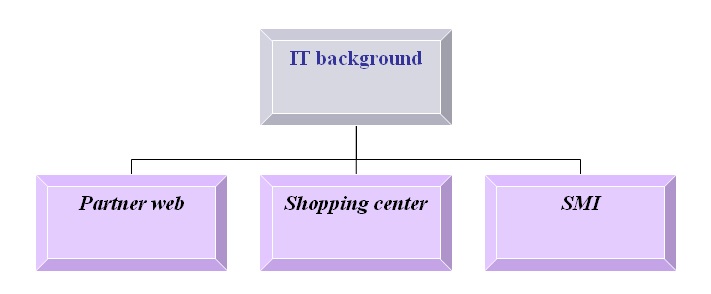
- Partner web: – This system is very much usable as it offers to all criteria of innovative information to the people as customers and other external stakeholders. Basic advantage of this database is that it delivers numerous supports to the value generation network in the formal development process. Above 4000 people can dynamically utilize this process recently that takes part 1/ 3 of the total number.
- Online shopping centers: – This version of technology has enabled the Danisco customers for making their orders through electronic medium as a reliable proof of administrative easiness.
- SMI or Supply management integration: – It permits the Danisco customers to incorporate with the IT process for designing customer orders and sound management of inventories regarding the basic structure of agreement.
Use of Pearson matrix and Rothwell’s five generation of innovation process
Since Danisco is observing its business modulation towards global trading, international and strategic entity, the overall innovative motto of the company can be visualized by the five stages of Rothwell’s theory of technological innovation. This theory is consisted of five phases as-
- Invention.
- Development.
- Innovation methodology or process.
- Consolidation and dispersion or diffusion.
- Improvement and redesign or modification.
Some of those stages are practiced in Danisco which can be examined as
- According to Rothwell, the invention phase emphasizes on push and pull marketing strategy technically which needs to negotiate pre- competitive, co- operative, R and D, specific boundary of competition, transparent no- economic factor for sartorial development etc. which can be observed at Danisco. Furthermore, innovation can be more advanced or fundamental which must affect different parts of economy while the company is going towards the way of assemblage, ethical values, broad area of IT and IS etc.
- Development is coming from various segments regarding informational virtues, flexible operations, social responsibility, service growth, outsourcing, employment if more workforces, CAM, CAD, cost savings which have generally been occurred over a period of time. The company also maintains sustainable development strategy involving safety, quality, security, guarantee, ethical view and complete products along with the company also maintains vendor auditing, environment measurement for ensuring quality, approval of goods, due attentiveness, back- up plan etc. Several sustainable techniques should be maintained, like- energy, customized process and control of poisonous materials.
- At the 3rd phase, the innovation and economic cycle would be restricted regarding the contextual and resource limitations. Here, Schumpeterian logic of technology can be applied through the natural implementations while SME companies can get the scope of creating some exclusive agenda. For example, Danisco inclusively incurs a significant amount of revenues for the innovative functioning which generally results in optimistic success in various existing and new fields’ like- bio- ethanol and detergents.
- The fourth dimension is considered important basically for energy and costs saving purposes. Thus, it has three major causes-
- National flow of internationalization.
- Expense of innovation.
- Formation of conglomerates.
For example, Danisco uses CRM and several IT tools to minimize its costs of communication and relationship management.
- The final phase would be composed of some redesigning procedure in which the company would have to pay attention to the international competitiveness and restrictions to become further expanded.
Suggested e-commerce process view
In the global market, the production is continued with the increased demand of products and services worldwide. The production is growing with the size and complexity of demand in most challengeable industries in the global market today. For this reason, the changes in product development and process improvement with the context of technological and cultural changes are must. The opportunities for product development are increasing with the innovation of new technologies not only for large industries, but also for SME (Small & Medium Enterprise).
Technological Innovation of Danisco
For this study of managing change and innovation of Danisco, the technological innovation is the main concern area. The ingredients of Danisco are well known in the global market, which have great expertise in innovation and technological improvement process as customers’ demand. (Danisco, 2007-2008)
For the innovation project of customers, expertise builds a team of network with needed skilled people. The team is working for customers in the development and improvement process in the market with confidentiality of customers. The research and development department is worked for Danisco Innovation resource management. External scientists and institutions are complementing the project work of technological innovation. The innovation management of technology is developing with the help of accessible and recent information of Danisco in the global market; one of the major issues of this development is E-commerce Process in Danisco. (DuPont Danisco, 2008).
Coordination among Danisco’s Existing process and Innovative technology
Choi, S., Stahl, D., & Whinston, A. B. (1997) provided the model of E-Commerce where they identified the difference between E-Commerce and traditional business and recommended that the function of E-Commerce is three-dimensional but the function of traditional commerce is mainly two-dimensional. The following figure demonstrates the position of e-commerce in back top right region; moreover, it recognizes the application of the process, importance of agents and the products as the function of these elements are the reason of differentiating E-Commerce and traditional commerce.
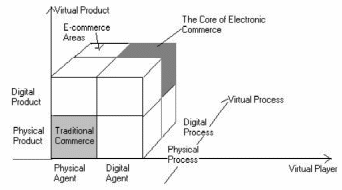
However, Riggins, F. J., & Rhee, H., (1998) addressed the four dimensional model for e-commerce and this matrix recognized potential advantages in implementing e-commerce solutions in the organisation.
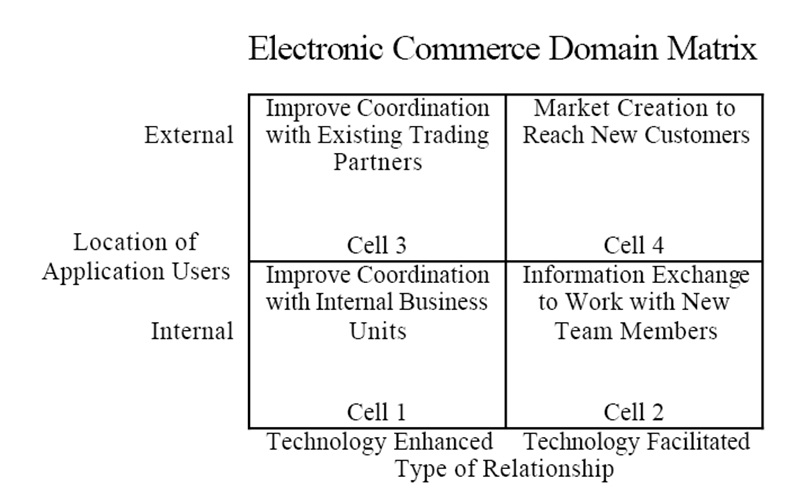
E-commerce Process of Danisco Sweeteners Ltd
Laudon, K. C. and Laudon, J. P. 2007 stated that e-commerce is the procedures of buying and selling products and services on the World Wide Web or internet. With the large usage of E-commerce in the world, today, e-commerce is divided into several parts. Some of these are:
- E-mailing: Virtual storefronts on web with online catalogs.
- Web contact: To gathered and use demographic data on web.
- Electronic Data Interchange: To exchange data in business to business transactions.
- E-mail: For reaching customers through media.
- B2B buying and selling.
- Security business transactions.
The process of e-commerce can defined as an essential to collect, store, and present back other businesses, stakeholders, and customers’ data with a proper format. In the technological innovation process of Danisco, E-commerce is a small portion. This portion is used as a business strategy of Danisco, which is not used in the visible part to customers. The business of Danisco, and also others business is growing so fast in the electronic way with the increasing usage of internet in worldwide. By using the modern e-commerce, Danisco is using electronic transaction’s lifecycle in the operation of their business. There are some familiar and efficient tools, which can be effective for their business, are:
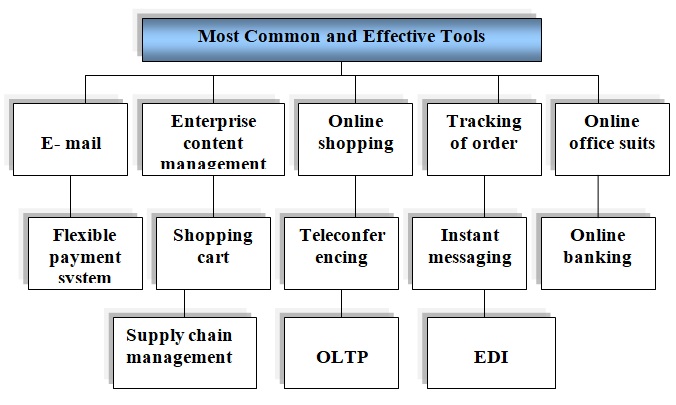
The proper implementation of these e-commerce tools can bring great success and effectiveness of Danisco, which are explained in the following study.
E-mail/ Electronic Mail
The method of creation, transmission, and store text based communications with people worldwide by digital communications systems, can be defined as Email. In 1980, the service of Email first started, which is called Simple Mail Transfer Protocol (SMTP). But modern email becomes more fast forwarded with the modern email computer server systems, which has the additional services of accepting, forwarding and storing messages of users in their personal computer or in the network systems. Most computers have email systems, some are single computer network and others are gateways to other computer systems. In this fast world, every company, whenever it is small or large, are using email services in large quantity because of its quickness, flexibility and reliability.
When same message can be send to several users at a time, is called broadcasting. Email system also has the text editor facilities in the composition of messages. The sent messages are also stored in the network systems until recycling. When any email received, many systems alert users. The email messages can be stored, forwarded, copied, printed or deleted, as users demand.
Email services can be used by Danisco for many reasons, which are:
- To send messages at any convenient time of employees.
- To send same messages to multiple recipients, with same contents.
- To forward information without retype, which can save time.
- To send and receive email with few minutes.
- To attach any digital files, like documents, video clips, music, photos etc.
Like all internet based email services, Danisco has to use the same methods, with some differences, which are:
- Danisco does not require any domain names in email address, without the sign of @ in internal mail
- They have to have two servers.
- When the top level employees of Danisco want to send any messages to co-worker, s/he requires only the user name or recipient’s full name while sending messages.
- If Danisco would use internal email system, then the company can not be connected to the internet, only can connect within the company.
- Danisco can prevent outside people like competitors from accessing internal data by using firewalls, which separates outside internal traffic and internal traffic of email.
- Danisco can use passwords and secure call block systems in the gateways of email services in the time of access email by employees.
In today’s world, SME business like Danisco, is adopting various technological innovation for developing its business. For this reason, Danisco should use the email services as communication medium for catching customers’ attraction and influencing b2b business process with other businesses.
Enterprise Content Management
Enterprise Content Management is an important strategy, method, and tool which is used for capturing, managing, storing, preserving and delivering content and documents of any organisational processes. It forms unstructured information into proper management strategy. The uses of enterprise content management are:
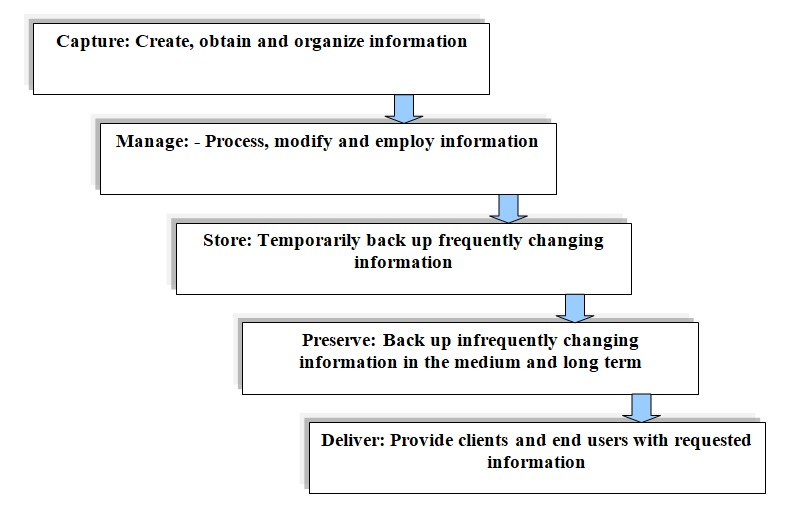
Enterprise content management is used by industries for documenting like news articles, manual of operators, technical manuals, sales guide of consumers, and marketing brochures and many more. The enterprise content management can be included with computer files, image files, media files, video clips, electronic documents and web content. (Oracle, 2007).
Enterprise Content Management has supported various features, which are:
- To identify all users and their roles in enterprise content management.
- To allocate roles and responsibilities of users according to content categories.
- To define tasks in workflow in creating, messaging and changing in content.
- To track and manage multiple versions of management content.
- To scan content.
- To publish content for access support to the content.
- To separate content’s layer from the layout of the content.
By adopting the features of enterprise content management, every organisation can be benefited in reducing costs in the following ways:
- Streamlined Process: It is a paper based processes, which can be improved by reducing storing of documents and shipping costs.
- Enlarged Productivity: This process can increase productivity of users and their group works.
- Infrastructure Combination: By this, content can be created in united way in documents, files, web content and digital assets.
- Hot Pluggable: This process can support third parties, security and applications of enterprises.
- Managing Diverse Content: This process can help organisations in diversification of contents for sharing multiple files with consistent categorisation.
- Satisfying Legal Requirements: Enterprise content management can records integrated management capabilities in storing and protecting business confidential records.
- Managing multiple web sites: It can publish content authorising tools and approval process in web content management capabilities.
For Danisco, Enterprise Content management would be an effective tool in e-commerce for generating smoothness in the organisation with improved technology.
Online Shopping
Online shopping is a convenient process for consumers to purchase various products and services through internet. It removes the physical presence of consumers by online shop, e-store, web shop, internet shop, online store, and virtual store. Online shopping is important types of e-commerce in b2b and b2c transaction systems. (Horrigan, 2008).
By online shopping, industries can be benefited by following criteria than physical shopping, which are:
- The bargaining power of consumers being less.
- The supplier power in digital source for consumers is less, so industries can be benefited without supplier’s contribution.
- The usages of internet through consumers are increased.
- Threats of new entrants does not effect badly in online shopping.
- It is easier to introduce new products and services online, so rivalry among competitors are less.
- The online shopping is convenient to both organisation and consumers.
- The searching information can be accessible to consumers and reviewed all products and services in easier way.
- The selection and pricing process is much easier in online shopping.

In the online shopping process, enterprises can deliver products and services through various ways, which are:
So, for Danisco, the online shopping is another effective e-commerce models for developing the enterprise in new dimensions and attracting customers for betterment of the organisation.
Shopping Cart
Basically, shopping cart is a trolley, carriage, buggy, baskets supplied by the shop, especially in super shops, while consumers are shopping. But in the definition of e-commerce, as an effective tool, shopping cart is software, while people or consumers shopping online, assisting them in making large purchases of products and services. In this process, consumers are placing their chosen items in a cart. Upon the cart, the checkout, calculation of total order, packaging, and postages are added as one after one. (Software Cart New Discovery to Handle Products!).
For Danisco, shopping cart is efficient while applicable to the consumers. The consumers will get help of large amount of products and services. They can get rid of the traffic of the customers in the online shopping systems. So, Danisco can adopt shopping cart in the technological development of e-commerce in their organisation.
Tracking of order
In the online transactions of products and services, most of the customers are complained about the improper way of getting their products and services, sometimes not getting the products and services. (FisherSci.com, 2005). For this reason, in the report of sales of consumers or suppliers, fulfilment of order of customers and other businesses, to track the order with the help of software is one of the important tools in now days in the e-commerce oriented business. (Nielson).
For Danisco, order tracking system is an important for removing the failure of product supply to customers, giving full satisfaction to customers, and keeping proper information of order in the inventory system of the organisation.
Online Office Suits
Online office suit is a form of software in services of internet enabled in the operating systems. The process system helps any organisation to work together at a time worldwide by virtual teamwork. A most popular online office suit is Web 2.0 paradigms in the development community as a free and open source for business. (IBM, 2009)
There are some advantages in the adoption of Office Online Suits in the organisations, which are:
- Low cost provider: – There are no specific charges applied for using office online suits by the users and organisations. So, anyone can access this with the computer in browsing to the internet.
- No need of Download: – in the web page, there is any need to install or download office suits. The new features and contents are automatically updated with the office suits.
- Low Hardware Requirements: – The office online suits do not require any additional hardware devices in the computer system.
- No need to Own Server: – The office online suits do not require any server system, while a group of people share any documents between them.
- Portability:- Users or organisations can access documents in their computers with portable office online suits in the connection of operating systems in the internet.
- Safety Server: – If the computer server system of users fails, the used documents are safe in the remote server with the proper storage system.
Online office suits have broad set of applications, which are shown in following:
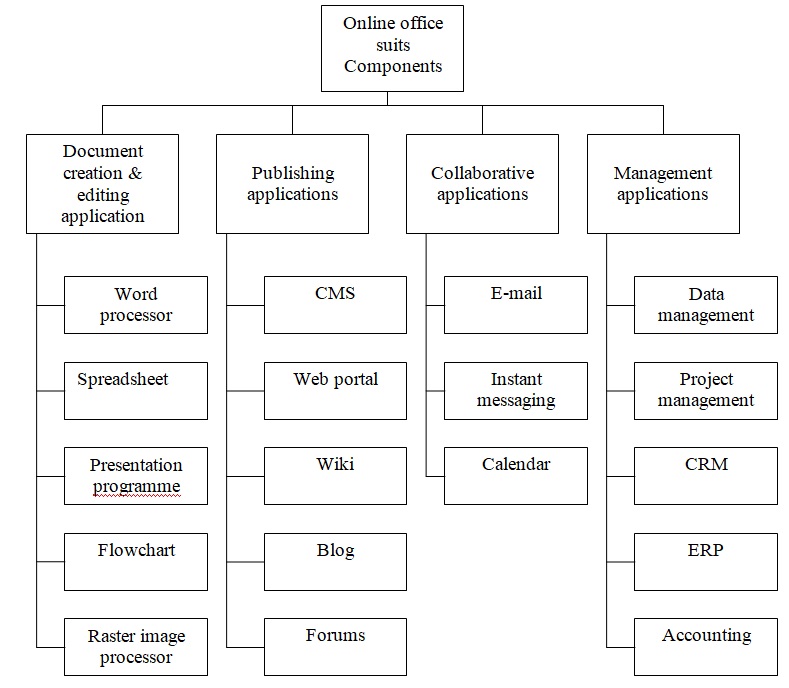
In Danisco, as a SME enterprise, it has to focus on the cost effectiveness of organisation properly. For this reason, to use office online suits as an efficient tool in e-commerce is correct decision for the management. It is almost free of costs and effective in various applications of online business with customers and other businesses.
Instant messaging or IM
Instant messaging is a sort of chat service enabled by internet, which renders the opportunity for the participants to establish a personal chatting channel and networks. This system uses the internet and alerts the individual user whenever any person of his/her personal chat list is online. By this, the user can notice who is on line and can start a chatting session. The key instant messaging service providers in the world are Yahoo! Messenger, MSN messenger and AOL messenger. Another supporting service of this is the voice based instant messaging. Through this, user can start a conversation session by just click on a talk button. (Laudon & Laudon, 2006).
Application in business
Companies, especially SME’s show great concern regarding security. To ensure credible security, most firms use instant messaging system in a proprietary based system including tools like Lotus Sametime. Some online based retail marketers designed their services for the SME’s, like Danisco, offering online instant messaging on their web sites. This feature attracts the visitors and as a result repeats purchase and customer satisfaction occurs. An SME can use Google talk, MSN and yahoo as an instantaneous communication tool. Besides, the concept of Enterprise Instant messaging (EIM) should be used in Danisco for better instant messaging usage. Enterprise Instant Messaging is the business level use of instant messaging for communication of a business purpose. Enterprise Instant messaging becomes a fastener for contemporary business existence. About 65 million businesspersons are using it as a media of their success. For Danisco, EIM is important for many reasons.
- IM cuts almost no cost or little to send or get a message. It is the most inexpensive way of communication compared with telephone calls or e-mail.
- As IM is one of the fastest and low friction bearing communication, participation in this system will surplus the time for Danisco.
- As compared to e-mail or voice mail, IM has the ability to avoid delay in conveying sensitive and time receptive information.
- IM has no time limitations. It is the simplest way to remain connected with persons working at any distance worldwide for a day, a week or for over the lifetime of any work needed.
- IM facilitate SME through the premise of synchronous networking communication. That is, it built on presence of the participants. The resulting outcome is the immediate decision-making and problem solving.
- Business people can use the IM through different types of communication devices, such as personal computers, cell phones, pagers and PDAs and so on.
- The most important aspect of IM is to facilitate the team communication. Group conversation and video sharing can be possible, whether the team members are situated in wherever I the globe. Thus, the traditional concept of business meeting gets an electronic and digital form.
- Boyd, (2007) argued that If management takes the IM aggressively, the productivity will increase and the communication cost will decrease, because IM smoothen the communication process without costing time and money.
Natural implementation
Danisco can implement IM manually or it can be a natural implementation. The key characteristics of IM are important for this implementation. The characteristics of IM are:
- Generation neutral: IM is a communication way, which is generation neutral. People of all age are now using IM as a communication and networking tool. Though the numbers of young users especially the teenagers are huge, IM is continuously getting an age neutral shape.
- Evolution: IM is considered as a unique and innovative type of communication tools. Its evolution is a continuous process. For example, now the use of headphone speakers to conversation and webcam for video chatting is a new technology.
- Sharing information: SMEs would be able to share different, critical and sensitive business information along with partners and team members by IM. SME business is critically using many information and demands immediate sharing of these information.
- Coordination: IM gives the opportunity to coordinate among information sharing related meetings. Mangers of the SMEs can discuss matters with a short form of chat and coordinate information.
- Presence: any one, who has the urgency to talk with a person, can easily find him/her online. Thus, presence is a key attribute of IM.
- Privacy: The chat over the IM is a private one. No one is allowed to interrupt or join in the conversation without permission.
- Attention: IM is a way of communication, which renders continuous partial attention. It means, in an IM person must give proper attention to the talk, which is may not happened in any other communication.
- Availability: As, IM can be accessible by various devices; an person can be available in almost all time.
- Placelessness: SME business needs small interactions and little requirements of place. IM does not matter for place. Any one from anywhere can do conversation with any person of any place.
Electronic fund transfer
Electronic Fund transfer is a way to transfer any amount of fund using any means of technology such as WEB, telephoning, computer and so on to command, initiate or authorise any financial institute to do necessary correction for an account as debit or credit. Here, straight payment can be possible from both businesses to business and customer to business. SMEs like Danisco, can easily do its bank payments to the banks through it. It can give Danisco the opportunity to use the electronic currency as its own.
Danisco can transact worldwide easily. The concept of credit card or debit card and other types of payment card accelerated transaction and reduce past hassles of transaction. Danisco can get favour of this card holding facilities for their customers. Beside, it can use the EFT to pay its employees, suppliers and logistics. Danisco has its various types of products and services and it can use the EFT as the only payment system for its customers to reduce their burdens.
- Transaction type: In EFT, different ways are present to do the transaction. Danisco, as a SME, can adopt these transaction systems for different type of transaction. For instance, it can use one type of transaction for its customers to pay for the purchase of products and choose another type of system to pay to its suppliers. In an electronic based transaction system, it is mandatory to ensure the consistency and reliability. Danisco can use many media to do this transaction. These can be-
- Electronic data interchange (EDI): This is the key media in electronic transaction system. This used mainly in transaction between two entities. That is, if anyone claims a payment through inline, it is an EDI.
- Web based applications: There are some web-based applications, which gives the entities to transact. These applications should upload in the web and make accessible for all.
This transaction can be of two major characteristics. These are –
- Authorisation: it means to have the right to access or to prevent unwanted access. This characteristic is important because if any one except the related parties wants to interfere in the transaction, authorisation power can take preventive and lawful steps against it. Danisco has sophisticated type of business transactions and also wide-raping information. If it exercises EFT authorisation power, it can be able to avoid these sorts of problems.
- Authentication: Use of card demands authentication in transactions. Danisco can perform the type of credit or debit card related transaction. Authentication refers to the authority to check the claim of a person about who is he or she. That is, an authentication means the possibility to verify the cardholder’s demography; account related information, particularly other transaction related information and many more. This authentication power is important because Danisco needs to have a clear access to the transaction history and to maintain it. SMEs are sensitive in transaction, whatever it is in form- traditional or electronic.
Supply Chain by Product Category
Danisco Sweeteners Ltd. has to drive aggressively to incorporate the process of producing its goods and services to evolve over with modern business process changes and information technological progression. Business managers of Danisco Sweeteners Ltd. would draw attention to answer the question on how it would automate production and trim down costs of labuor. Danisco has to aware when efforts would be underway including the production line, the sky-scraping quality system would be integrated to producing goods taking into account of increasing market demand, stock inventory, fluctuating customers needs and the total quality management of Danisco would convey fast and efficient e- Supply Chain Management.
The business managers of Danisco Sweeteners Ltd. have to realise that the well line up they have to stroll connecting adequate inventory levels as well as inventory obsolescence where the measures of the up-stream suppliers and down stream customers have a forceful influence on the business process to formulate and shift products and services. By accepted wisdom of the up-stream as well as down stream trade process as an incorporated e-supply chain management, the business managers of Danisco Sweeteners Ltd would be able to meet demand with raising revenue growth, cost cutback and asset consumption.
The new beginning of logistics carried out by information technology as well as logistics networks which allow the business managers of Danisco Sweeteners Ltd to manage the e-supply chain. Handfield, R. B. & Nichols, E. L. (2007) argued that Supply Chain Management would incorporate the functions linked with the course of renovation of finished goods starting from raw material phase up to the consumers level including allied information flows with an enhanced supply chain to accomplish a substantial competitive advantage.
Mehta, T. (2002) argued that in actual fact the supply chain take account of internal and external process as well as information surges. In broad-spectrum, the Danisco Sweeteners Ltd and its business units would take control over the internal course of action consequently the external processes would be influenced to a convinced level that are required for the whole process. Thus Danisco Sweeteners Ltd would concentrate only on its internal processes as well as inter-organisational information surges that are integrated with supply chain although it necessitates noteworthy efforts to achieve results. Figure bellow demonstrates the internal supply chain of Danisco by product life cycle.
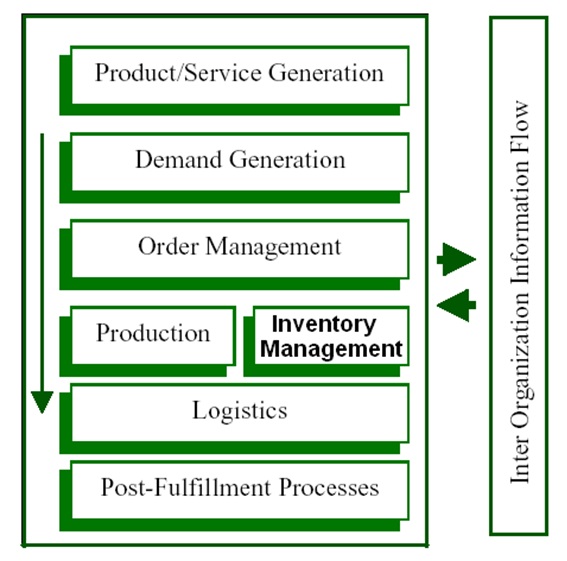
In every stage of Danisco’s internal supply chain there are huge prospect to take part in inter-organisational information flow and Danisco would not share information for the period of the product invention stage.
Customer service management procedure
Cohen, S., and Roussel, J, (2005) argued that it refers the connection between the company and its buyers. One of the main functions of customer service is to supply instantaneous information to the buyers and it includes information about manufacture and distribution processes. In order to upgrade Danisco’s SME status, it should change its present SCM structure through the following processes-
- It should select equally agreeable objectives between company and clients,
- It should establish and uphold purchaser relationship and
- It have to create positive approach in the company and the buyers
Sustainability measurement
Sustainability in development is a key business issue. Sustainability of Danisco is an integrated approach of its management philosophy and internal cultural factors. Sustainability refers to keep balance in demand and supply. This balance is maintained in Danisco through some dynamic and continuous way. There are three area of focus, where the sustainability of Danisco can be measured. These are social responsibility, health & safety and environment.
Danisco designed its supply chain management in a way that ensures the social responsibility. It treats the employees as its main resource and ensures the work time safety and some after work facilities. It has a good relationship with its suppliers. But, it thinks customer as the ultimate asset and designs its operations to customer friendly.
Danisco has a key goal regarding betterment of customer’s health and their safety. Their target is to reduce he accidents and to a zero injury. By using different technologies, Danisco can achieve its goal of ensuring 100% health & safety.
Technologies innovation to prevent the environment from its operation is another sustainability measurement issue for Danisco. Danisco is totally careful about its surrounding environment and use its technologies to protect the environment. As an example, it is reducing its water and energy consumption at a minimum level for last many years.
Internet marketing
Internet marketing refers to the marketing of products or service through the internet. Internet can facilitate every stage of marketing such as branding, promotion, advertising selling and packaging. To find different types of marketing tools, marketers are now using internet often. More interaction and individualisation is possible in internet for both the marketers and the customers. Some important aspects of internet marketing are:
- One-to-one approach: Through internet, marketers can get the personal attention of the customer. Customers search information and product in internet mostly alone and thus the personal interaction between the marketers and the customer is possible. Though the interaction is virtual without any physical appearance, the effect of this marketing is almost same to person selling. Thus, it terms as one to one approach.
- Particular interest approach: Internet is a type of media, which is different from all other media. Marketing in traditional media is not easy as through internet. It is easy because internet marketing uses particular interest approach. A person surfing in the net has a common pattern of interest. Danisco can also use this approach It can place it marketing advertising in such webs which are related to the business of Danisco.
- Geo marketing: Geo-marketing is an advanced approach of marketing. Customers of a product or service may situate in different geological location. Geo marketing means to target promote and sell a product to a person living in a geologically distant place. Now, it becomes easier for the use of web and internet. Danisco can do geo marketing to attract its foreign customers and to expand its business globally everywhere.
- Category by choice: Customers has differences in their interest. Internet gives the chance to categorise the products. Customers can differentiate different categories of product and also compare different product offerings of different company. Danisco also get these advantages by using Internet marketing. Customers choose a category and order the relevant one through internet. These ease the product choosing and selection can attract more customers.
- Automated content: Automated content is a key feature of internet-based marketing. It means to gather information automatically and update new features of product on internet instantly. It can facilitate the product search cost of the customers. An automated content service ensures the satisfaction of customers and creates customers that are more loyal.
- Facilities: Internet marketing provides some unique facilities to the marketers. Marketers can promote their products in a less expensive way and also get instant attention from the customers. Marketers can also oversee the customer appearance and actions through internet. Customers of all age can be able access the products.
- Security factors: Different types of actions of people make the internet-based marketing vulnerable. Hacking, cyber vandalism, spoofing, sniffing, denial of service attack, identity theft, cyber terrorism and cyber warfare are the key type of security related problems. This problems crate threat to the personal information of both customers and marketers. To ensure security, Different types of software are designed. Danisco can also use software and organise some ranking system. It can invest largely on E-marketing bonding solution and collection system of sophisticated software.
- Use of broadband related advertising: Internet marketing gives the opportunity to the SMEs like Danisco to use the broadband advertising. To become a customer friendly company and creation of effective brand value, Danisco can do broadband related advertising.
Electronic data interchange (EDI)
Laudon and Laudon (2006) argued that electronic data interchange (EDI) enables organisations and individuals to take part in standard transactions such as in procurement order, invoices, bill of exchange, shipments’ information etc. This helps to transmit dataset without paper works. It functions automatically through a network from a computer system to another computer system and therefore it becomes a cost effective scheme for data exchange. The EDI (Electronic Data Interchange) standards define the construction and information fields of electronic documents for the specific organisation. For Just-in-time’s (JIT), application of EDI is highly important, because it has automated data dissemination. The EDI is the least expensive way for transmitting messages over internet protocol in comparison with the former VANs (Value Added Networks). The Danisco would get the following advantages by properly employing EDI standards in its e-commerce structure:
- Reducing costs: EDI, by itself, completes data dissemination over networks and therefore reduces labor costs. Moreover, due to the collaboration with the EDI standards, there is a decrease in paper work and therefore costs reduction. So, in addition to system smoothing, business operation costs of the Danisco and its partners would be minimised dramatically.
- Competitive advantage: as EDI provides cost minimisation facilities, therefore the firm, using the standards, has cost leadership over its competitors. The cost leadership refers to the minimisation of business operating costs to such an extent so that the firm can offer products and services at a lower cost than that of its competitors. By being a fast and efficient means of documents sharing, EDI helps the firms to collaborate with its partners beyond its generic reach and thus gives competitive advantage over traditional paper based competitors.
- Process simplification: It is known that EDI automatically processes orders with the highest accuracy and therefore, order-handling processes become convenient, sharp, and simple.
- Streamline sales: EDI, if properly employed, reduces the time of placing, receiving, and checking up of an order. Then it sends invoice to the customer’s computer and issues a shipping order. Therefore, EDI makes the payment of the transaction to be held promptly.
- Flexibility of data dissemination: In paper work, firms can rarely enjoy flexibility in the representation of data because these data have to be encoded into the system later. However, though customers and partners of the firm send different types of data from different systems, EDI translates these transmitted data into uniform data resource so that these are usable by the users.
- Automation of B2B transaction: EDI automatically processes data without any kind of human interventions. It usually does retrieval of data, verification of data, and creation of EDI documents for employees use, without the employees’ interventions. Therefore, maintaining relationship with partners and holding transactions thereto become easier.
While taking decision to employ EDI in its e-commerce operation, the Danisco should consider the following features of an EDI:
- Effectiveness of data management: for having the most effectiveness of data management, the firm should seek information about the following questions:
- Can the EDI create meaningful business transactions from raw data?
- Is there database update possible?
- How does the EDI manage inventory, customer, and order data?
- Integration of transactions: EDI usually standardizes business data so that different users can use these in different computer systems. Usually, EDI receives non-uniform data from customers and partners of the firm. Therefore, integration of these transactions into the system is a major concern to choose EDI standards.
- Efficient processing of transaction: To be efficient in transaction processing, the firm should check whether any paper work is required in the system or not, the average error rate of the EDI standards etc.
- Inbound and outbound transactions: Here the firm should consider how inbound and outbound transactions are handled by the EDI. The major activities related with inbound and outbound transactions are inclusion of invoices into the system, placement of shipment notices in relation to ship and warehouse, handling of purchase orders and their revocations, if any, etc.
- Automation of procedure: To automate the business processes EDI should have the capability of making sales orders from purchase orders automatically. Moreover, capability of creating shipment notices to warehouse after creation of invoices thereto is also required.
- Efficient communications: To ensure efficient communications, the firm should ensure that the EDI has the flexibility of handling wide varieties of information from wide varieties of sources, the computer systems.
Online Shopping
Victoria, (2004) addressed that the e-procurement, shopping online, means purchasing with the aid of internet. A typical online shopping constitutes the following step:
- Search for the product and grab information about the product and its supplier on the web;
- Download the product catalog of the seller or supplier;
- Send email to the seller for enquiry, if any;
- Placement of order to the seller online;
- Settlement of payment through the seller defined payment system.
According to MSBCS (2008), the Danisco has to have online shopping cart software in its e-commerce website. Shopping cart software must have three different parts namely product catalogue (information about products, delivery system, payment system etc.), shopping list (list of selected products), and checkout system (add items to cart).
Online payment systems
Laudon and Traver (2007) addressed that to pay electronically, there are several systems available. There are several types of standards to securitize the online payment systems such as SET, SLL etc. According to around 80% of online payments in 2005 had been taken place through credit cards. They further added the common electronic payment systems as the following:
- Digital cash: the most former alternative payment system that has been used as online payment system. Digital cash is not cash at all rather is a form of value storage and value exchange. It has limited convertibility into other forms of value. It requires intermediaries to convert its value into other forms.
- Online stored value systems: Laudon and Traver (2007) also added that online stored value system as an online account where value is stored and which permits to make payment online based on the stored value. It depends on value stored in the consumer’s bank, checking account and/or credit card account. The Smart Cards are also used as stored value system. These cards look like credit cards but they inherit chips that contain personal information.
- Digital accumulating balance payment systems: Consumers at first make micro payments and purchase online and these accumulated debit balance at the end of the month is billed against the account. Some familiar digital accumulating balance payment systems are:
- Qpass
- Valista
- Clickshare
- Click & Buy
- Peppercoin
- Paypal
- Digital credit accounts: Digital credit accounts issue credit card specially designed for making payment online. For example, e-charge is such a digital credit card system.
- Digital checking account: digital checking account is specially designed checking account to aid in online payment. Some familiar digital checking accounts are:
- PayByCheck.
- Western Union MoneyZap.
Danisco has to consider the present online banking movement in developing its e-commerce because almost all successful banks of UK are now operating online. It has to consider the PayPal and other similar online payment systems too.
In addition to the decision about what type of online payment system should the Danisco use in its website; it has to consider some participants in the online payment.
VeriSign (2009) described participants in an ordinary online payment:
- Acquiring bank: Internet merchant accounts are provided by the Acquiring bank. For online credit card authorisation and payment processing, a merchant must have a merchant account with an Acquiring bank. For example, Merchant e-Solutions is an Acquiring bank.
- Credit card association: credit card associations are credit card facility provider financial institutions and are distributed by consumer banks. For example, Visa® and MasterCard®.
- Customer issuing bank: customer issuing banks are consumer banks that represent its consumers and therefore are liable in case of its consumer’s defaults.
- Internet merchant account: a special account provided by Acquiring bank for allowing merchants to accept credit card. The merchant usually pays a processing fee to the Acquiring bank.
- Payment gateway: payment gateway is a third party operated service that allows the merchant, customer, and financial institution to take part in the online payment. For example, VeriSign is a payment gateway service provider.
- Processor: is a data house where credit card transaction is handled and settled. Usually the merchant website inherits such a processor through the payment gateway.
Danisco also has to take decision how it would authorise and settle online payment in its e-commerce site. It may employ the ordinary authorisation and settlement process or can tailor the authorisation and settlement process for itself. According to VeriSign (2009), a typical authorisation process is as the following:
- Consumers took decision of purchasing on the e-commerce site and therefore, in the check out s/he places credit card information;
- The website receives the credit card information and then it transfers the information to the payment gateway;
- The transaction data sent to the payment gateway is routed to the processor for the settlement and accomplishment of the transaction.
- The processor asks authorisation from the consumer’s bank by sending the input data;
- The consumer’s bank then verifies the information and either authorises or cancels the transaction;
- After receiving authorisation or cancellation, the processor sends the transaction result to the payment gateway.
- The payment gateway further passes the transaction result to the merchant;
- The merchant then either accepts the transaction and issues shipment of goods or cancels the transaction.
According to VeriSign (2009), the usual settlement process is as the following:
- The payment gateway is requested by the merchant to settle a transaction;
- The payment gateway accumulates all the necessary data and then passes the data to the processor;
- Then the processor, by analyzing the data sent to it, sends transaction details simultaneously to the consumer’s bank and the merchant’s acquiring bank;
- The consumer’s bank debits its consumer’s credit card account and the Acquiring bank credits the merchant’s account in response to the transaction analysis sent by the processor.
The Danisco also has to consider the security measures for the online payment system. Allin, J, (2005) mentioned that in its online transactions, it has to ensure its consumer about the safety of their given data. In this aspect, it has two options: data interception and data encryption.
Data interception: The malicious internet users can intercept information that is transmitted through both wireless and wire means. By placing computer on a network, one can easily intercept information through Ethernet. Because Ethernet can easily interpret the electronic signals sent over a network. As there are many applications available to monitor data across the network, it is easy for anyone to intercept the sent data. Allin, J, (2005) also argued that, interception is an inevitable problem in terms of security of a system and therefore, to ensure the system’s security, interception is to be carefully handled. According to by Allin, J, (2005), the following measures should be taken by Danisco to limit data interception:
- Ensure that both the machines of client and vendor are well set up with proper authority and have enough security measures against unauthorised use and access thereto.
- Ensure that the computer systems are equipped with anti-virus software to save the systems from being susceptible to safety sphere holes.
- Ensure the use of firewall. The computer system should have set up firewall so that others cannot invade the system and enjoy the weaknesses of the system.
- Ensure the least use of wireless technology because it is more vulnerable than wire networks. And the firm also has to ensure no trespass to the server room and to the sensitive computers.
Recommendation
After explaining all such e- commerce tools, it can be noticed easily that all of those techniques are not equally appropriate for long and short- run application. There must exist some variation in implementing scheduling of which should be followed according to the following guidelines-
Long-run recommendation
For the longer period of operating business, Danisco should focus on the maintenance of policies, procedures and laws. All of those technologies will provide a foundation but the absence of intelligence management policies can be defeated. Thus, a security plan needs to be developed as below:
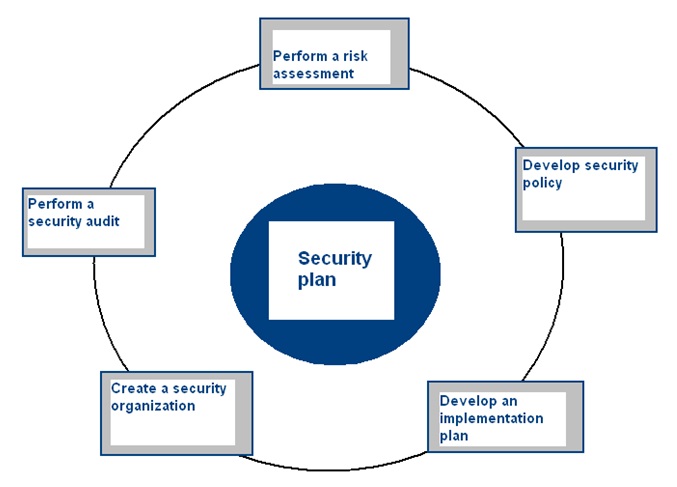
For minimizing security threats, Danisco must develop a consistent corporate policy which takes into description the role of risks, the information resources needs to be secluded and the policies and techniques required to identify the risks along with the implementing and auditing procedures.
- Risk assessment. It is assessment of risks and issues of vulnerability. The first step is to inventory the knowledge resource and information of the e- commerce part of the company which involves business functions, designing property, secrecy system.
- Develop security policy. After examining the probability or rating system by making a qualified chart of risks, a security policy can be developed in terms of a statement for consolidation the information risks by eliminating agreed upon target of risks and identifying those techniques for such target achievement.
- Implementation plan. It refers to the action steps that must be taken for obtaining the security plan goals. It is essential to determine how to translate the level of acceptable risks by utilizing tools, techniques, policies and procedures.
- Create a security organization. For such implementation; there exists a need of corporate unit in charge of security and security head. These security organizations educate and train users, make administration conscious of the security challenges and threats by reserving the tools preferred of applying security. Further, access controls decide who will gain genuine contact to the network. Authentication procedure involves the utilization of digital signatures, certificates authority as well as public key infrastructure. Here, a biometrics should be conducted after which authorization policies for determining different levels of access to the data would be obtained.
- Perform a security audit. It will reflect a routine review of accessing the logs. Here, a caution against the tiger team must be maintained to ensure security.
- Proper control of IM: The instant messaging system must be governed by the separated IT department of Danisco that will be adequately enabled in such handling to avoid risks.
- Electronic fund transfer or EFT: System of EFTPOS and card based EFT should be introduced along with Danisco should try to bring flexibility in payment system by letting the users more options for making an easy online trade.
- Internet marketing: To remove the problem of low speed of internet for reducing productivity can be overlooked by adopting industry standard e- business suppliers for re- guaranteeing the customers with a flexible policy of returning as with delivering pick- up facilities within the shop.
- Association with other companies: Danisco can make further steps of conforming security concern of the customers by building extra delivery of its goods by conducting with other branded e- tailors by the concept of leveraging secondary equity with them or response rating technique as well as e- marketing bonding software.
Short-run recommendation
Several short-run suggestions can be as below-
- The e-mail context should be as simple as possible with adequate security and will provide less opportunity for the employees or users to do any abuse with this.
- Use of e-mail can be better substitute of expensive physical meeting, video conferencing or telephone calls.
- Danisco should also have bulletin boards, chat rooms for assessing more customer database.
- The information database must be simple enough and thus be upgraded over time-to-time.
- Several software applications must be also upgraded over time frame.
- The company should publish online electronic brochures to attract more third parties and web users.
- Preparation of a single statement of each of them with a vision of creation of values,
- Flow-charting of the functions in terms of change along with the goal.
- Make a yearly or 6 months measurement to compute the additional revenue per workforce, level of customer satisfaction, reduction of inventory, increasing amount of sales, share of the market and profitability ratio.
- Online payment system like- PayPal, Google, or credit cards also be useful in offering “back-end” customer security system for identifying problems because of their actual happenings.
- Rip and rid technique instead of initializing the EDI system.
Limitations
The study of referencing various e- commerce tools in the corporate context of implementation may suffer from some limitation factors. Such as-
- Rapid use of e-mail can not always be resulted in better outcome as it is subject of general website problem of lack of security, abuse and mostly dependent on users lack of synchronization or willingness for seeing the information which can reduce the weight of a potential information.
- It is also a subject of losing context for ever, two way communication and inconsistency as it creates difficulty while a larger team works on the same documents without having a fluctuated contact with each- other.
- ECM is also a subjective matter of problem in conventional legacy addressed in document and archive management. Additionally, it involves in alteration to and forming electronic content, to and from the automated channel of such difficulty domains. For example- visible and computerized stodgy and retrieval method that includes certificate as well as microforms. And finally, it faces problems in its personal right since it includes techno-based and digital control of content for identifying venture processing strategy like auditing, record, division of expertise and knowledge, customisation and standardization of index etc.
- Implementation of instant messaging system without a development of distinctive IT department can generate risks and liabilities for Danisco Company for the lack of efficient controlling it along with switching of communication media and multi tasking are regular practice here.
- Inflexibility in using electronic fund transfer for all sorts of users.
- Since internet marketing emphasizes the customers for utilizing more modern technologies rather than conventional ones, slow speedy internet can create a major barrier of using that. As Danisco will operate in larger and merely complicated networks, personal connection through with internet by dial- up technique or mobile diplomacy will cause great delays in getting outcome. From the shoppers viewpoint, the inaccessibility of smelling, touching, tasting or experimenting upon a product prior to the chance of composing online purchase is also restricted. Functional limitations can otherwise be targeted as inability of measurement result, lower grade of inner capacity along with problem in pursuing top management.
- There exist some barriers for implementing electronic data interchange. First, accomplishment of changes process of the venture. The company surrounding with slow speed of exchanging physical transaction cannot run with EDI system and with an alteration of automating the documentation process. Secondly, it requires huge money and time for the initial formulation. The over expensiveness have been resulted from the primary establishment, training and standardization can create a larger which may be out of affordability for many companies like a SME. Third problem exists in the sense of natural perception to it by many SME’s of the country.
- Online trading process suffers problems of security, safety and expenses. It can also lead to the wastage of huge money and time. However, it is already been a subject of making unnecessary delays for huge amount of processed data.
- Online shopping is similarly suffering the problem of many customers’ perceptional choices of making physical shopping.
Conclusions
As popper of innovation, SMEs like those that Danisco Sweeteners Ltd may drivers to integrate new technology akin to e-commerce system restructuring organisational development. It is therefore significant for governmental agencies, legislation of UK and the organisations are allies to get ready themselves to take action properly to match with managing changes and innovation.
Nevertheless, the adaptations e-commerce scheme within the organisation and responses of the stakeholders in the case of Danisco has augured to initiate managing changes and innovation had occurred. This integration of new technology has created better circumstances to take the advantages of innovative initiatives to minimise the costs and maximise profitably of the organisation
Bibliography
Allin, J., 2005. E-Commerce/Web Security. Web.
Applegate Directory Ltd 2009, Products and Services of Danisco Sweeteners Ltd., Web.
Andam, Z. R., 2003, e-Commerce and e-Business, Web.
APO, 2002. Asian Cases on supply Chain Management for SMEs. Web.
Berdegué, J. A. Biénabe, E. & Peppelenbos, L 2008. Innovative practice in connecting small-scale producers with dynamic markets, Regoverning Markets, Web.
Bjørn-Andersen, N & Andersen, K. V., 2004. Diffusion and Impacts of the Internet and E-Commerce: The Case of Denmark, Globalisation of E-commerce. Web.
Board of equalization, 2006. Sales and USE tax regulations. Web.
Boyd, S., 2007. Enterprise Instant Messaging: Ethics, Etiquette, and Best Practices. Web.
Bowersox, D. Closs, D., and Cooper, M. B. 2002. Supply Chain Logistics Management, 1st ed., McGraw-Hill/Irwin: London. Web.
Christopher, M. G., 1998. Logistics and Supply Chain Management, 2nd Edition, Pearson Education: London. Web.
Choi, S., Stahl, D., & Whinston, A. B., 1997, The Economics of Electronic Commerce, Indianapolis, IN: MacMillan Technical publishing.
Cohen, S., and Roussel, J, 2005. Strategic Supply Chain Management, 2nd ed., McGraw-Hill: London. Web.
Cooper, S., Rayson, P., Botchway, B & and McCafferty, R., 2005. Performance Measurement in UK textile & clothing manufacturing SMEs: Regaining the initiative. Web.
Danisco. 2008. Danisco strengthens strategic platform through acquisition of Agtech. Web.
Danisco. 2005. Danisco in brief. Web.
Danisco. 2008. Annual Report 2008 of Danisco. Web.
Danisco Sweeteners Ltd, 2008. The Handling and Processing of Litesse: In the Manufacture of Chocolate Products, Redhill, Surrey. Web.
Danisco A/S 2004. Danisco Sustainability Report 2004. Web.
Davenport, Thomas & Short, J. 1990, The New Industrial Engineering: Information Technology and Business Process Redesign, in: Sloan Management Review.
FisherSci. 2005. Requisition and Order Tracking. Web.
Franco, M. J., 2001. Collaboration Amoung Firms as a Mechanism for Innovation: Portuguese SME’s Innovative Behaviour, Web.
Fred, C.P. M. Sollish et al, 2007, The Procurement and Supply Manager’s Desk Reference, 1st edition, Wiley, London. Web.
Gueco, C., Ryan, N., & Walker, P. 2007. Innovative financing for sustainable small and medium enterprises in Africa. Web.
High-growth, Innovative Asian SMEs for International Trade and Competitiveness: Challenges and Solutions for APO Member Countries, Web.
Gankema, H. G. J., Snuif, H. R. & Zwart, P. S (2000) “The internationalization process of small and medium sized enterprises: An evaluation of stage theory,” Journal of Small Business Management, Vol: 38(4), 15-27.
Goldfinger, C. & Perrin, J. C. 2001, E-Finance And Small And Medium-Size Enterprises (Smes) In Developing And Transition Economies, UNCTAD Background Paper.
Gide, E. 2007, A study for establishing E-commerce Business Satisfaction model to measure e-commerce success in SMEs, Int. J. Electronic Customer Relationship Management Journal Vol. 1, No. 3, 307, Central Queensland University, Australia, Web.
Gulam, M., & Shariq, I., 2005, Development of e-Commerce in SME’s (Business-2-Business Perspective). Web.
Handfield, R. B. & Nichols, E. L., 2002. Introduction to Supply Chain Management, 3rd edition, London: Prentice Hall. Web.
Hammer, M. 1995. The Reengineering Revolution, 1st Edition, Hammer & company, New York. Web.
HIPAA, 2003. Hipaa information series, Are you a covered entity? Web.
Horrigan, J. B., 2008. Online Shopping, Web.
Griffin, R. W., 2006. Management, 8th Edition, Houghton Mifflin Company, Boston New York. Web.
INEP, 2000, Implementing the Montreal Protocol in Small Businesses: Chemical Management under a Multilateral Environmental Agreement. Web.
Kotler, P., Armstrong, G. 2006, Principles of Marketing, 11th Edition, Prentice-Hall of India Private Limited, New Delhi. Web.
Kotler, P., 2006, Marketing Management, 11th edition, Prentice Hall, NJ. Web.
Laudon, K. C., & Laudon, J. P., 2006, Management Information Systems, 9th edition, New Jersey: Pearson Prentice Hall.
Laudon, K. C. & Traver, C. G., 2007, E-commerce: business, Technology, Society, 3rd edition, New Jersey: Pearson Prentice Hall.
Laudon, K. C., Traver, C. G. 2002, E- commerce, Business, Technology, Society, 4th Edition, Pearson Education, Delhi, India. Web.
LEKTOR, 2006. Report on Case Studies: Legal Knowledge Transfer Accelerator for SME related for SME. Web.
Martin, J., and Roth, R. 2007. Supply Chain Management, ECRU Technology Inc. Web.
Mann, D., Poon, J., & Driver, M., 2006, Case Studies from a Breakthrough Innovation Product Design Programme for Local Industries. Web.
McKay, J & Marshall, P, 2009. Strategic Management of E-Business, John Wiley & Sons, Inc. Web.
Mehta, T., 2002, E-commerce and Supply Chain Management: Fitting the Pieces Together, Hewlett-Packard Company, CA. Web.
Microsoft Corporation, 2007, E-Commerce Gateway-EDI Edition. Web.
Michigan Department of History, Arts and Libraries, 2006, Frequently Asked Questions about E-mail Retention. Web.
MSBCS 2008, E-Commerce: Purchasing and Selling Online. Web.
Nielson, 2008. BookData Online – Quick Guide for Order Tracking and Real Time Supplier Data. Web.
Oracle Data Sheet, 2007. Oracle Enterprise Content Management. Web.
Payne, J E., 2003. E-Commerce Readiness for SMEs in Developing Countries: A Guide for Development Professionals. Web.
Payne, J. E. 2002, E-Commerce Readiness for SMEs in Developing Countries: A Guide for Development Professionals, Academy for Educational Development, U.S. Agency for International Development (USAID). Web.
Pool, P. W., Parnell, J. A., Carraher, S., 2003. Utilizing E-Commerce in Small Business. Web.
Riggins, F. J. & Rhee, H., 1998. Toward a Unifed View of Electronic Commerce, Web.
Simchi-Levi, D., Kaminsky, P., & Simchi-Levi, E., 2003. Designing and managing the supply chain: Concepts, strategies, and case studies, New York, NY: McGraw-Hill.
Skinner, S. J., & Ivancevich, J. M. 2003. Business for the 21st Century, Homewood, Boston. Web.
Stoner, J. A. F., Freeman, R. E., & Gilbert, D. R., 2006. Management, 6th Edition, Prentice-Hall of India Private Limited. Web.
Strauss, Judy. El-Ansary, Adel. Frost, Raymond, 2006, E-marketing, 4th edition, Prentice Hall, London. Web.
Tellumat telecoms, 2008, Tips for SMEs in a connected world. Web.
UNCTAD Expert Meeting, Palais des Nations, Geneva, 2001. Web.
VeriSign, 2009. How to Create an E-Commerce Web Site. Web.
Victoria, 2004. Buying and Selling Online. Web.
